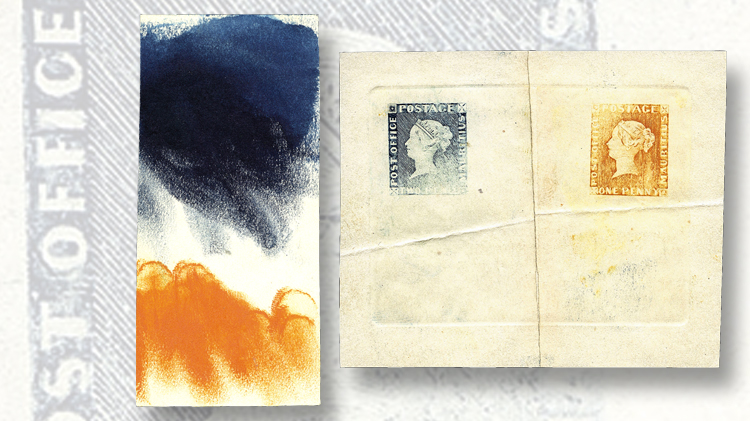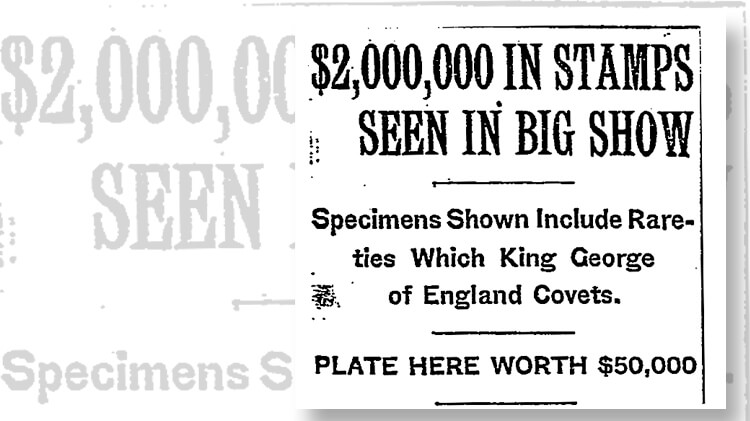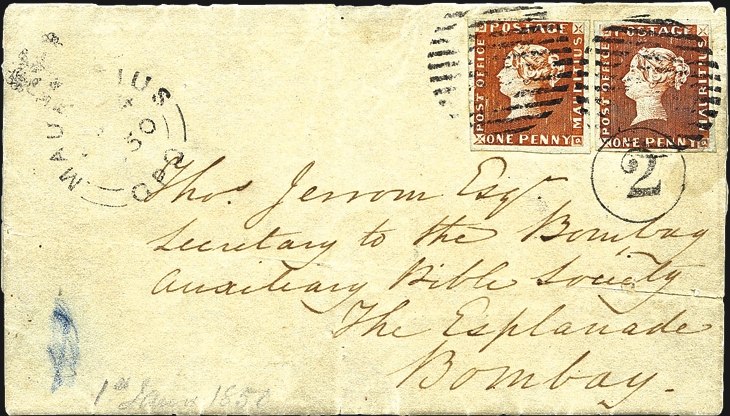Auctions
Two Mauritius philatelic treasures each topped $1 million at auction
By Matthew Healey, New York Correspondent
The long-awaited sale of two of philately’s most prized items took place in Geneva on Dec. 1, when the famous Mauritius “Post Office” copper printing plate was hammered down by David Feldman for €1.1 million, and the famous Bombay cover franked with two rare 1-penny “Post Office” Mauritius stamps realized €2 million.
Taken together with the 20 percent buyer’s premium, that equals slightly more than $1.4 million for the plate, and more than $2.5 million for the cover (at $1.06 to the euro).
The new owners, who remain anonymous, are reported to be private collectors.
Connect with Linn’s Stamp News:
Sign up for our newsletter
Like us on Facebook
Follow us on Twitter
This marks the first time the printing plate has ever been traded for a publicly disclosed amount.
The sale was previewed on Linns.com Nov. 13; the rediscovery of the plate, which for half a century had been thought lost, was first reported online on March 10, 2015.
 The set of Bavarian mint sheets that brought $1.68 million at Gaertner sale: Many of the sheets in the set, which were described as “museum-quality,” were unique or one of just two surviving.
The set of Bavarian mint sheets that brought $1.68 million at Gaertner sale: Many of the sheets in the set, which were described as “museum-quality,” were unique or one of just two surviving.
The plate measures about 3.2 inches by 2.4 inches (81.05 millimeters by 60.6mm) and weighs about an ounce and five-eighths. It shows one mirror-image cliche for each of the first two stamps issued by Mauritius in 1847. The impression on the left is for the 1d stamp, which was printed in orange (Scott 1), while the one on the right printed the famous 2d “Blue Mauritius” (2).
The stamps were modeled on Great Britain’s Penny Red and Two-Penny Blue of 1841, and show Queen Victoria surrounded by the words “Post Office,” “Postage,” the country name and the denomination.
Mauritius was the first British Empire territory (outside of Great Britain itself) to issue postage stamps. The tiny Indian Ocean colony was just the seventh country in the entire world to introduce stamps for the prepayment of postage, after Great Britain, Brazil, three Swiss cantons and the United States.
The issue was undertaken locally on the initiative of the governor, Sir William Gomm, who commissioned the engraving of the plate by Joseph Osmond Barnard, an Englishman who was said to have stowed away on a ship to the island in 1838. Just 500 examples were printed before the plate was retired.
Many of the stamps were used up by the governor’s wife for invitations to a ball. Just 27 are thought to have survived. The rare remaining “Post Office” covers are considered among the greatest treasures in all of philately.
A second stamp issue was made the following year, from a plate inscribed “Post Paid” instead of “Post Office.” For a long time, philatelic lore held that the original inscriptions were done in error by some fictional half-blind watchmaker, but research has completely debunked this tale.
The legend of how the printing plate vanished, reappeared, vanished again and finally resurfaced in 2013 is, however, quite true.
Some decades after it was retired from use and disappeared, the plate resurfaced in the hands of one Dominic Henry Colnaghi, a nephew of Lady Gomm, who sold it to London stamp dealer Nevile Stocken in 1912.
Stocken supposedly turned down an offer of £2,500 from the Imperial Postal Museum of Berlin and sold the plate instead to David Field, a prominent dealer, who resold it to a collector named Sydney Loder for an undisclosed price.
The plate was displayed publicly in London in 1912 and, after a few tiny marks were made to it, a limited reprinting was taken at that time.
It was displayed at New York’s first international stamp show the following year, when a New York Times headline speculated that the plate was worth $50,000, which, adjusted for inflation, would be around $1.2 million today — very close to what it just sold for.
Around the time of its 1930 display at Berlin’s Iposta exhibition, the plate was sold to legendary collector Maurice Burrus, a French industrialist, again for an unknown amount. He last showed the plate to the public in 1935.
When Burrus’ extensive philatelic holdings were auctioned in 1963 following his death, the plate was not among them, and it was again presumed lost to the philatelic community.
But it turned out that he had given it as a gift to his niece, Odile. When she passed away in 2013, family members found the plate among her affairs, and in 2015 they approached the firm of David Feldman, which has a long record as an auctioneer of early Mauritius rarities.
After an 80-year absence, the plate went on a fresh world tour, being exhibited in London, Monaco, Singapore and most recently at World Stamp Show-NY 2016.
The Dec. 1 sale included several of the proof impressions taken from the plate over the years, as well as one of the famous covers bearing the original stamps.
A rejoined proof impression shows each stamp in its respective color, looking rather underinked. It has been claimed that this proof may have been made by Barnard himself. Although this has not be proven, extensive study showed the proof does indeed predate the 1912 reprints. Accompanied by a piece of card with color swatches of the original orange and blue inks, the proof sold for $121,000.
 Handwritten letter from Fidel Castro: How much did Siegel sell it for?: The 1958 letter describes recent action and concludes with the words “¡buena suerte!” (good luck!) and his distinctive signature, “FideCastro”.
Handwritten letter from Fidel Castro: How much did Siegel sell it for?: The 1958 letter describes recent action and concludes with the words “¡buena suerte!” (good luck!) and his distinctive signature, “FideCastro”.
Several of the reprints from 1912 and later were offered, each selling for about $1,500 to $2,000.
But the piece de resistance of the sale was the famous Bombay cover.
Discovered in a street market in India in 1895, the cover bears two large-margined examples of the 1d “Post Office” stamp, tied by barred cancels on a cover addressed to Bombay.
The cover was bought by Raymond Weill in H.R. Harmer’s 1968 sale of the Dale-Lichtenstein collection for $380,000, then a world-record price for any philatelic item.
It had changed hands only privately since then, and had been exhibited at the Interphil exhibition in Philadelphia in 1976, where its contents, a letter about a shipment of scriptures to the island, were revealed for the first time.
The cover has now gone to a new owner for $2,548,000.
MORE RELATED ARTICLES
Headlines
-
US Stamps
Oct 7, 2024, 3 PMMcMurtrie dismissed as APS education director following Sept. 21 arrest
-
US Stamps
Oct 7, 2024, 12 PMVasiliauskas named president of Mystic Stamp Co.
-
US Stamps
Oct 6, 2024, 5 PMApgar souvenir card available
-
US Stamps
Oct 6, 2024, 4 PMFirst Continental Congress and U.N. stamps receive Scott catalog numbers












